A faint constellation in the northern sky between Gemini and Leo. The inverted "Y" lies in the centre of an equilateral triangle formed by the stars Pollux, Regulus and Procyon. It is formed by the stars Altarf, Acubens, Asellus Australus, ι and χ Cancri. 2000 years ago, the Sun passed through Cancer at the time of the summer solstice, so it was the northernmost constellation of the zodiac. It currently passes through it from July 20 to August 9. However, the sign of Cancer still marks the summer solstice and the tropic is called the Tropic of Cancer in the northern hemisphere. At present, the Sun rises highest in the northern hemisphere at the boundary of the constellations Gemini and Taurus. Cancer is the least prominent constellation of the zodiac, with only one of its stars exceeding 4th magnitude. A moonless night is therefore a prerequisite for seeing the constellation at its best in the sky. Cancer boasts two open star clusters, some of the most beautiful in the entire sky. The brighter one is M44, located almost in the centre of the constellation. In ancient times, in 270 BC, the Greek poet Aratus called it "Praesepe". Several centuries have passed since then, when Galileo Galilei first resolved them into individual stars with a telescope in 1610. Nowadays, a simple binocular will do the trick. There are also several binary stars in the constellation, and because it is further away from the Milky Way, we can find a greater number of fainter galaxies.
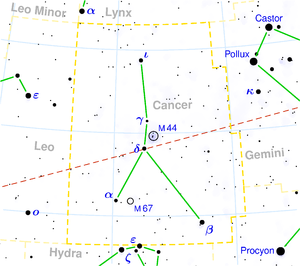
ι2 Cancri - A triple star system that cannot be resolved even with a 30 cm telescope. Under good observing conditions, it is visible only as an elongated star, with a hint of a primary yellow and a secondary blue component.
Acubens (α Cancri) - Double star distinguishable only with a larger telescope. The companion is located 11.3" away from the primary component (4.25 mag), but it is about 1,000 times fainter and has a brightness of only 11.8 mag in the sky. The system is located at a distance of 164 light-years.
X Cancri - The variable star with a distinct red hue changes its magnitude from 5.6 to 7.5 mag approximately every 195 days, suitable for observation in binoculars. It is located near the star δ Cancri.
Tegmin (ζ Cancri) - The triple star, with its two most prominent components at magnitudes 5.6 and 6.2, are separated by 5.7", which can be observed with a 5 cm telescope. Their mutual orbital period is approximately 1,100 years. The brighter star itself is a close binary - its companion with a magnitude of about 6 can be resolved at a separation of 0.8". It can be well distinguished with a telescope with a 300 mm objective diameter. Its orbital period is 59.6 years, and in 1991, its separation was only 0.5".
R Cancri - The variable star of Mira Ceti type with magnitude changes from 6.1 to 11.8 and a period of 362 days.
M 44
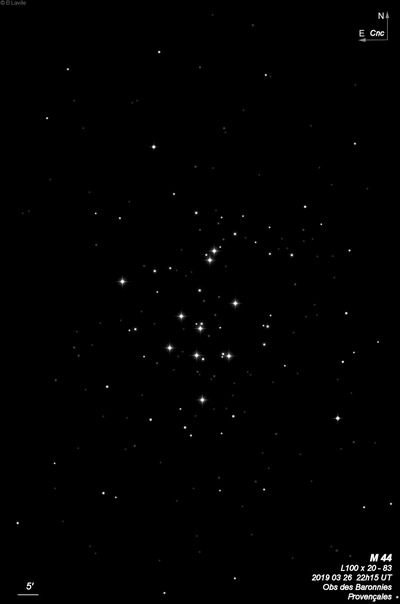
Aratos of Soli made the first written mention of M44 = Beehive cluster about 260 BC in his work Phainomeina (called a "little mist") and it was probably noted 100 years earlier by Eudoxis. It was later recorded by Hipparchus around 130 BC as a "little cloud". Galileo made the first known telescopic observation that clearly resolved M44 into a star cluster, though a few stars may be glimpsed naked eye under excellent conditions. His observation of 1610 in Siderius Nuncius ("Starry Messenger") reads "The nebula called Praesepe, which is not one star only, but a mass of more than 40 small stars, I have noticed 36 stars besides the Aselli."
The earliest found reference to the nickname "Beehive" is from Admiral Smyth's Bedford Catalogue of 1844: "The Praesepe, metaphorically rendered Bee-hive, is an aggregation of small stars which has long borne the name of a nebula, its components not being separately distinguishable by the naked eye…"
Naked-eye - fairly bright fuzzy glow in dark skies. Granular with a few resolved stars in excellent conditions.
Notes by Steve Gottlieb
M 67
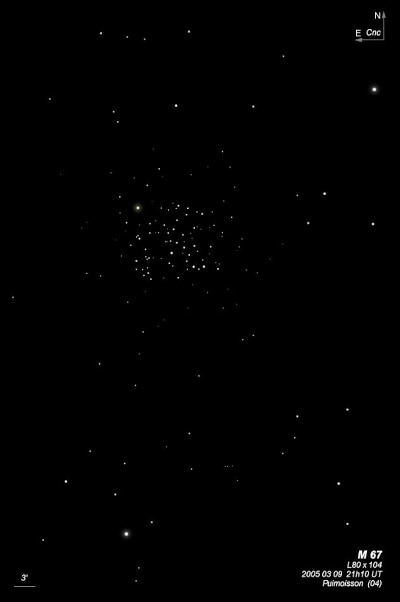
Johann Gottfried Koehler (discoverer of M50 and M60) discovered M67 = NGC 2682 = h531 before 1779 and recorded "A rather conspicuous nebula in elongated figure, near Alpha of Cancer." Messier independently discovered it on 6 Apr 1780 and logged "Cluster of small stars with nebulosity, below the southern claw of Cancer. The position determined from the star Alpha [Cancri]." William Herschel first observed the cluster on 26 Mar 1783 using his 6-inch and simply noted a "cluster of stars." With his 18-inch in 1784 he described "a most beautiful cluster of stars; not less than 200 in view."
M67 is an old open cluster with age 3-4 billion years (Sue French states 2.6 billion years in March 2009 S&T while Astronomy mentions 3.2 billion in the Apr 2012 issue. The position given in Lynga #5, Sky Catalogue 2000, NGC 2000 and Deep Sky Field Guide (first version) is about 1.0 min of RA too far west.
300/350mm - 13.1" (12/22/84): about 100 stars mag 10-15 in 15' diameter, very rich and impressive cluster.
13.1" (3/24/84): beautiful at 88x with over 75 stars resolved at this magnification.
400/500mm - 17.5" at 140x about 200 stars mag 10-14 in a 15' diameter. Includes several rich subgroups including one on the south edge near three brighter mag 10 stars. The brightest star mag 7.8 SAO 98178 is just off the NE edge.
Notes by Steve Gottlieb
NGC 2775
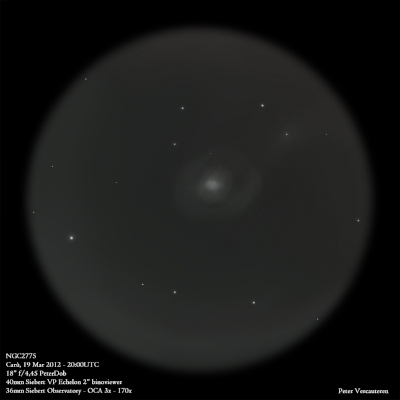
William Herschel discovered NGC 2775 = H I-2 = h564 on 19 Dec 1783 (internal discovery #16 in sweep 57). His summary description from 5 sweeps reads "cB, cL, R, vgbM, with nucleus." On 23 Dec 1827 (sweep 116), John Herschel wrote, "vB; R; psbM; 2' diam; the hazy border perhaps extends further; resolvable??" Samuel Hunter, the 72" observer on 28 Mar 1861, also thought he could resolve this galaxy, reporting "R, vgbM like a glob. Cl, I see stars plainly at times."
200/250mm - 8" fairly bright, bright core, elongated.
300/350mm - 13" (2/23/85): bright, fairly large, elongated NNW-SSE, bright core, stellar nucleus.
400/500mm - 17.5" (3/29/89): bright, very large, elongated 4:3 NNW-SSE, small very bright core, stellar nucleus, large faint halo. Near the edge of the field is NGC 2777 11' NNE (physical companion) and NGC 2773 13' NW (background galaxy).
Notes by Steve Gottlieb
NGC 2750
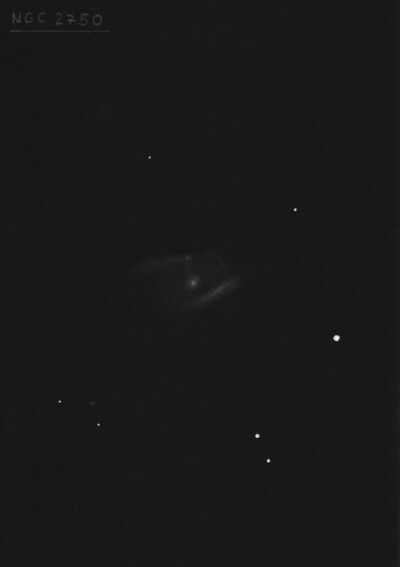
William Herschel discovered NGC 2750 = H III-291 on 11 Mar 1785 (sweep 384) and remarked "vF, pL, R, bM." Auwer's reduction placed this object 1° too far north, but this error was caught by John Herschel when he compiled the GC. Heinrich d'Arrest made 4 observations, first on 21 Feb 1863.
400/500mm - 17.5" (4/6/02): fairly faint, fairly small, round, 1.0' diameter. Moderately concentrated to a small bright core and a stellar nucleus. Forms the NE vertex of a right triangle with mag 9.7 SAO 80618 4' WSW and a mag 11.5 star 3.5' SSW. A superimposed companion on the west side was not seen.
17.5" (4/6/91): fairly faint, fairly small, round, even concentration to a small bright core, halo gradually fades into background. Located 3.9' NE of mag 9.3 SAO 80618.
600/800mm - 24" (3/22/14): fairly faint to moderately bright, moderately large, strong concentration with a very small bright core and quasi-stellar nucleus, fairly large slightly elongated halo 1.2'x1.0'. A very faint, elongated brightening was visible at the west edge. This object is catalogued as KPG 186A = PGC 93099, but on the SDSS it appears more likely to be a bright, knotty, star forming region.
Notes by Steve Gottlieb
NGC 2608
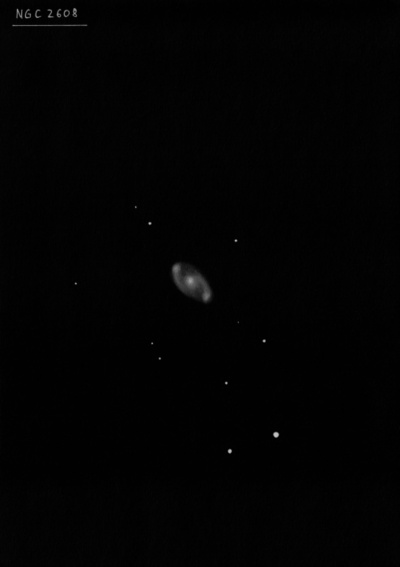
William Herschel discovered NGC 2608 = H II-318 = h512 on 12 Mar 1785 (sweep 385) and noted "F, pL, lE, mbM, r." His position was ~14 seconds of time west of UGC 4484.
The galaxy was observed 8 times at Birr Castle and spiral structure was highly suspected several times. On 14 Feb 1857, the observing assistant noted "..twist [spiral arms] in the nebulosity p and f the nucleus, most apparent preceding." and the 1 Feb 1856 observation reads "E nearly p f, the p half is much the brighter and I think has curve in it [in a sketch there appears a dark space p the Nucl].
Two supernovae have been discovered: Max Wolf discovered SN 1920A (considered anomalous) and Type Ia SN 2001bg.
300/350mm - 13.1" (1/18/85): fairly faint, moderately large, elongated 2:1 WSW-ENE, small bright core. Two mag 11 and 12.5 stars are 5' S with separation 1.3'. NGC 2619 lies 33' ENE.
400/500mm - 17.5" (5/19/01): Supernova 2001 bg (discovered on May 8, 2001) visible as a mag 14 star at the southeast edge of the galaxy [22" E and 19" S of center].
Notes by Steve Gottlieb
NGC 2535
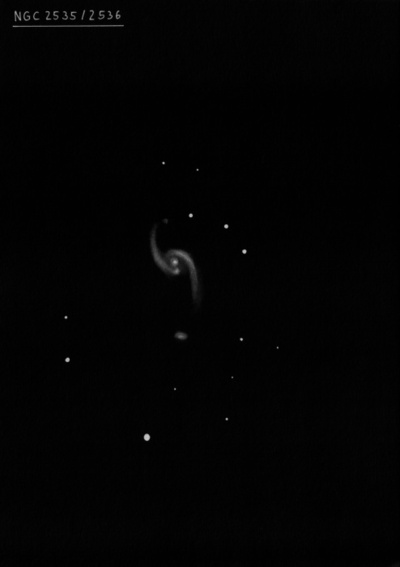
Édouard Stephan discovered NGC 2535 = St VIIIb-26 on 22 Jan 1877, along with NGC 2536. His position matches UGC 4264.
SN 1901A in NGC 2535 (one of the first found) was discovered by Karl Reinmuth in 1923 on a Heidelberg plate taken on 10 Jan 1901. The announcement was made in 1924AN....221...47R.
300/350mm - 13.1" (1/18/85): faint, small, round, diffuse, even surface brightness. Located 22' SSE of a mag 6 star.
400/500mm - 17.5" (2/20/88): fairly faint, fairly small, slightly elongated SW-NE, weak concentration. Forms a close pair with NGC 2536 1.8' SSE (Arp 82). Located just following a line of three mag 12 stars 1.6' WSW, 1.2' W and 0.9' NW of center.
900/1200mm - 48" (4/2/11): this is the prominent member of a striking interacting pair (Arp 82) with NGC 2536 1.8' SSE. At 375x appeared bright, fairly large, elongated 5:3 SW-NE, ~1.6'x0.9' (including arms). Contains a relatively large, bright core spanning ~40"x30" and punctuated by a very bright, stellar nucleus. Attached at the west side of the core is a graceful spiral arm that curves clockwise towards the south-southeast in the direction of NGC 2536. The arm faded towards the south-southeast end though increased in length with averted vision. Still, it didn't reach the smaller companion. A second arm is attached on the east side and shoots north, though it's only 2/3 the length of the southern arm. A string (1.4' length) of three mag 12-13 stars is off the west side of the galaxy.
Notes by Steve Gottlieb
NGC 2735
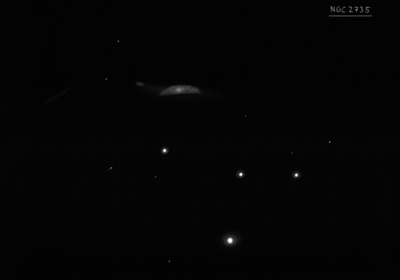
Édouard Stephan discovered NGC 2735 = St IX-18 on 26 Feb 1878 using the 31" reflector at the Marseille Observatory and recorded as "small star enveloped in a vF, vS neby, lE E-W." His position is exactly 1.0 tmin of RA east of UGC 4744 although his offset star is correctly placed. The error was caught and corrected by Esmiol in his re-reduction of Stephan's position.
400/500mm - 17.5" (4/6/91): fairly faint, fairly small, elongated 2:1 E-W. There are four bright stars to the south. Three of these stars oriented WSW-ENE form a shallow arc; mag 10 star 1.6' S, mag 9.1 SAO 80591 3.2' SW, mag 9.0 SAO 80590 4.6' SW. Also mag 7.2 SAO 80592 lies 5' SSW (2' S of SAO 80591).
600/800mm - 24" (3/22/14): moderately bright and large, very elongated 3:1 E-W, 0.9'x0.3', contains a bright elongated core. Forms a close pair (VV 40 = Arp 287) with NGC 2735A = PGC 25402 just 45" ENE of center, but detached. At 375x, the companion appeared very faint and small, round, only 10"-12" diameter. Situated 4.9' NNE of mag 7.3 HD 77313, along with three mag 9-10 stars even closer.
Notes by Steve Gottlieb
NGC 2623
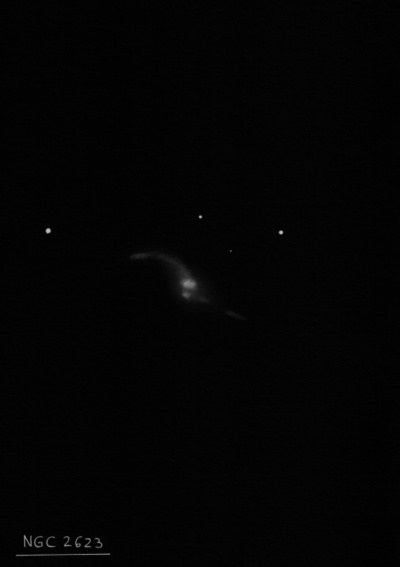
Édouard Stephan discovered NGC 2623 = St XIII-41 on 19 Jan 1885. His position matches UGC 4509 = Arp 243.
300/350mm - 13.1" (1/11/86): faint, small, slightly elongated, weak concentration.
900/1200mm - 48" (2/28/19): this system is a late-stage galactic merger and contains two relatively prominent tidal tails. At 488x and 610x it appeared bright, moderately large, sharply concentrated with a very bright bar-like core ~E-W. The core was slightly brighter at the west end. Both tidal tails were visible with much difficulty. The eastern tail was slightly brighter and curved north and then east (bending counter-clockwise) from the central region. This arm was visible with direct vision and perhaps 0.9' in length. The southern tidal tail was pretty straight and more diffuse, extending southwest, ~0.7'. Both tails were fairly even in surface brightness and faded only towards the tips. A mag 17.5 star (not difficult) is 0.9' NW of center.
Notes by Steve Gottlieb
UGC 4414
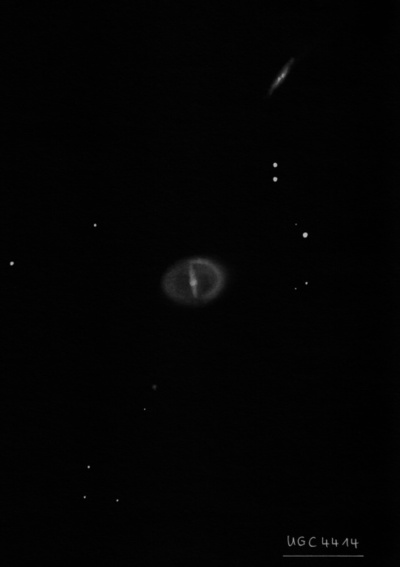
600/800mm - 24" (2/24/20): at 260x; bright stellar nucleus dominates faint "wings" (bar) oriented SSW-NNE. Occasionally this is surrounded by a very low surface brightness halo, but it was not resolved as a distinct ring. CGCG 119-101 is 3.8' NNW. Located 13' NW of NGC 2595.
Notes by Steve Gottlieb
IC 2431
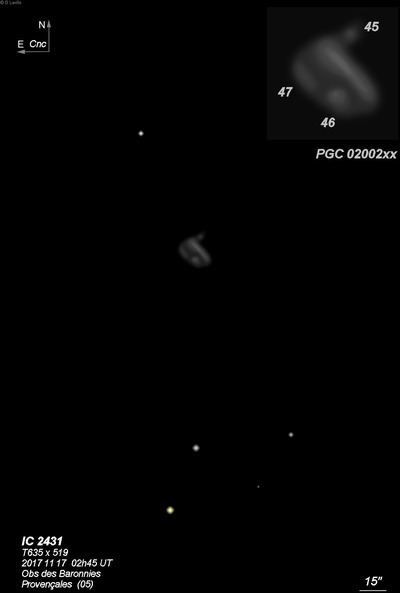
Stephane Javelle discovered IC 2431 = J. 3-1068 on 24 Feb 1896 with the 30-inch refractor at the Nice Observatory. His micrometric position is accurate. Javelle's third catalogue gives the observation date as 24 Feb 1906. If that's the case, it's his last discovery and a couple of years after the previous one.
UGC classifies IC 2431 as a quadruple system. The V-V Atlas of Interacting Galaxies II, has the note ""Browning". Three?" The name "Browning" probably refers to a Browning pistol, which it resembles in the atlas.
900/1200mm - 48" (2/21/12): at 488x this compact 25" quartet was resolved into a trio of adjacent, extremely small "knots" (galaxies) each ~8" diameter, within a common halo. One or two seemed to have a stellar nucleus including the knot on the south side, which corresponds with SDSS J090434.82+143536.3 = LEDA 200246 (V = 15.7). The other two knots are very close west and northwest (LEDA 200245). A mag 12 star is 1.7' NNE. The seeing was fairly poor at the time of the observation, so I needed to wait for steady moments to resolve the components.
Notes by Steve Gottlieb
HCG 37
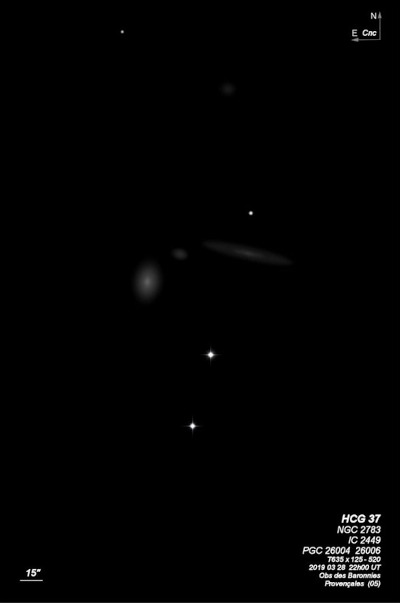
| Type | GALCL [E2] |
| RA | 09:13:35.7 |
| Dec | +30:00:51.0 |
| major_axis | 4.2' |
| mag | 11.5 |
| surface_bright | 99.9 |
Abell 31
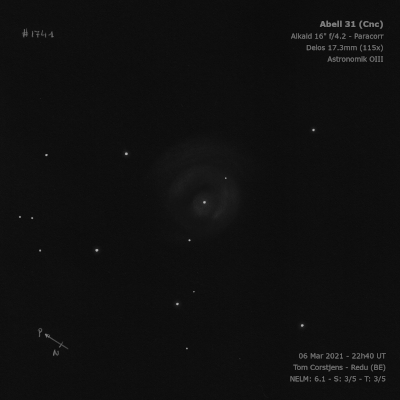
| Type | PN [3a] |
| RA | 08:54:13.2 |
| Dec | +08:53:53.0 |
| major_axis | 16.8' |
| minor_axis | 15.6' |
| mag | 12.2 |
| surface_bright | 18.0 |
HCG 36
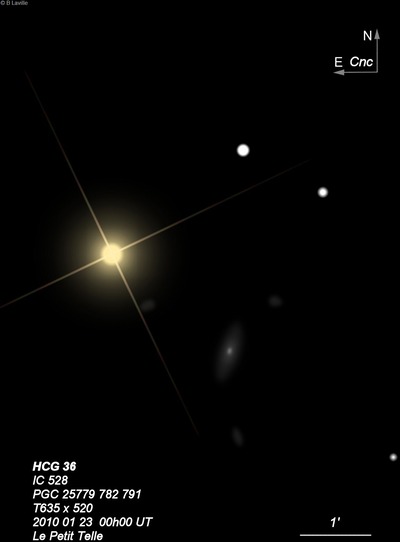
| Type | GALCL [S1] |
| RA | 09:09:23.7 |
| Dec | +15:47:44.0 |
| major_axis | 2.5' |
| mag | 12.5 |
| surface_bright | 99.9 |
Abell 30
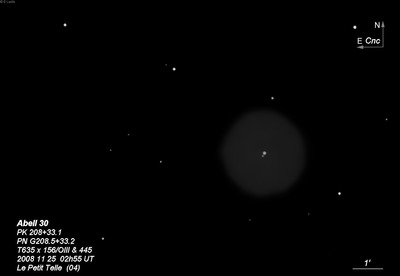
| Type | PN [2c] |
| RA | 08:46:53.5 |
| Dec | +17:52:46.0 |
| major_axis | 1.8' |
| mag | 15.6 |
| surface_bright | 16.6 |